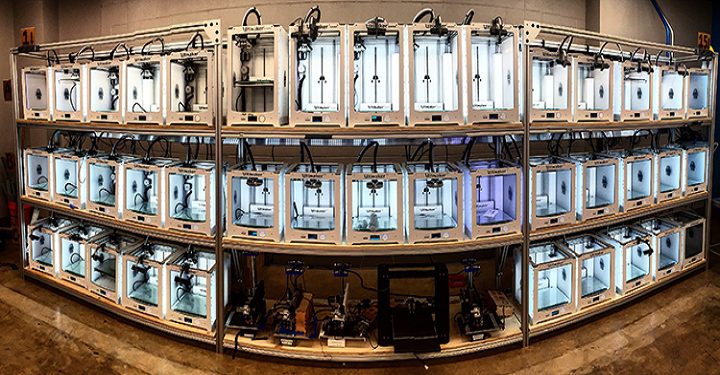Mathematical Model Determines Which Spare Parts Should or Should Not be 3D Printed
A major potential AM application for many industries is using the technology to fabricate spare parts on-demand in an effort to get rid of warehouses that are stocked full of spare parts just waiting to be used. Obviously, this could help save both time and money, but just how feasible is this solution?
Companies now have an important choice to make – continue stocking spare parts, or only 3D printing them when they’re needed. Sounds simple, right? Maybe not. According to Jeannette Song, an operations professor at Duke University’s Fuqua School of Business, parts suppliers realize they need to keep spares handy, but since they’re not psychic, and don’t know what will break and when it will do so, they also know that they need a range of parts, in large quantities no less, available in inventory at any given moment.
“It takes up space and capital, and there is the risk of spoilage and damage,” Song said, explaining how inefficient and costly this decision can be.
Having a digital inventory of 3D printable spare parts means that manufactorers can forget about keeping a wide variety of parts on hand just in case they’re needed. However, this approach comes with its own set of issues.
“But that means you don’t have what you need on hand exactly when you need it, because 3D printing takes time. So there’s a trade-off,” she explained.
 Song determined that a hybrid approach of the two – printing some parts when necessary, but continuing to keep others stocked – is the most useful way to proceed, but it’s tough to know which parts should be kept in inventory and which ones should be 3D printed. To help manufacturing firms determine the pros and cons of 3D printing on-demand spare parts versus storing spare parts, she came up with a useful mathematical model.
Song determined that a hybrid approach of the two – printing some parts when necessary, but continuing to keep others stocked – is the most useful way to proceed, but it’s tough to know which parts should be kept in inventory and which ones should be 3D printed. To help manufacturing firms determine the pros and cons of 3D printing on-demand spare parts versus storing spare parts, she came up with a useful mathematical model.
The model is based on an equipment manufacturer that’s moving into a new international market – the utility industry, which relies heavily on spare parts. When parts wear out, or power fails, these companies need to get replacements out to the field quickly in order to restore or maintain service, and not just a few at a time, either. For example, a transformer is typically made of up to 36 different molded parts.
“For utilities, when you don’t have spare parts on hand, it’s a huge disruption. They have to have reliable and responsive supply of spare parts,” Song explained. “Traditionally a firm in this position would have a huge warehouse in every market. But now 3D printing is a viable alternative, so you have two options.”
The manufacturing firm she based her model on will be providing spare parts to utility companies that don’t have the necessary infrastructure to house them. Together with Yue Zhang, currently an assistant professor at Pennsylvania State University who helped with the research during her time working toward her PhD at Duke, Song published a paper describing the mathematical model, titled “Stock or Print? Impact of 3D Printing on Spare Parts Industry,” in the Management Science journal.
“We present a general framework to study the design of spare parts logistics in the presence of three-dimensional (3-D) printing technology. We consider multiple parts facing stochastic demands and adopt procure/manufacture-to-stock versus print-on-demand to highlight the main difference of production modes featured in traditional manufacturing and 3-D printing. To minimize long-run average system cost, our model determines which parts to stock and which to print. We find that the optimal 3-D printer’s utilization increases as the additional unit cost of printing declines and the printing speed improves. The rate of increase, however, decays, demonstrating the well-known diminishing returns effect. We also find the optimal utilization to increase in part variety and decrease in part criticality, suggesting the value of 3-D technology in tolerating large part variety and the value of inventory for critical parts,” the abstract states.
“We also derive various structural properties of the problem and devise an efficient algorithm to obtain near optimal solutions. Finally, our numerical study shows that the 3-D printer is, in general, lightly used under realistic parameter settings but results in significant cost savings, suggesting complementarity between stock and print in cost minimization.”
Completely getting rid of spare parts inventory is often too chancy, but 3D printing some of the parts on-demand can help keep costs down, which is a hybrid approach is often the best. Companies can use Song’s mathematical model, which can effectively calculate which specific spare parts they will most likely need more often, how many of these should be kept in inventory, and which parts aren’t as vital, so they can be 3D printed on-demand when needed.
“If you are operating on a large scale, you still need to keep inventory on hand. But a little flexibility goes a long way,” Song said.
“The big decision is how you rationalize all these parts, which ones to stock and which ones to print. In most cases we find a 3D printer would not be used very much at all, but the firm saves a massive amount of inventory.”
Discuss this story and other 3D printing topics at 3DPrintBoard.com or share your thoughts in the Facebook comments below.
(Images: Duke University, unless otherwise noted)
The post Mathematical Model Determines Which Spare Parts Should or Should Not be 3D Printed appeared first on 3DPrint.com | The Voice of 3D Printing / Additive Manufacturing.
To 3D print or not to 3D print on demand? Duke professor tackles stock queries
Bioengineers 3D print a liver-like air sac using food dyes, opening doors for replacement organ printing
3D Printing News Sliced: Sintratec, HP, 3D Systems, Renishaw
3D Printing Industry research CrAMmed: MIT, National Academy of Engineering, Aalto University, Optomec
Bright lights of 3D printed lithium-ion batteries demonstrated by DukeU and Texas State
Duke University’s 3D Printing Innovation Lab Allows Surgeons to Create Accurate 3D Printed Medical Training Models
3D printing is becoming increasingly more accessible and affordable in many industries, including the medical field. We often see the technology used for the purposes of creating accurate training models and simulators, so that medical professionals can practice surgeries and procedures ahead of time – this not only saves on costs, but can also allow surgeons to offer a better level of care.
Tawfig Khoury, MD, an otolaryngology (ear and throat) resident at Duke University, is focused on the latter, and uses 3D printing to improve patient care. He makes 3D printed medical models of the ear’s delicate temporal bones, which are later used for the purposes of medical training.
“One focus of my research has been taking CT scans of temporal bones, and printing an exact, patient-specific replica. Our residents can then practice drilling and performing other tests without having to work on an actual patient,” Dr. Khoury explained.
Dr. Khoury works on his 3D printed models at the university’s Innovation Co-Lab Studio, which contains a network of over 80 3D printers, ranging from MakerBot and Markforged to Ultimaker and Formlabs, that have been used for various projects since the facility began to really grow last year and explore new uses for 3D printing at the university.
“With recent renovations, we now have a state-of-the-art facility, with high-end equipment across an entire floor dedicated to the lab,” Dr. Khoury said.
“The Innovation Lab is a great example of how different departments across the hospital, as well as other healthcare groups, residents, and students, can work together to create something of value for the community.”
The lab, previously described as a “creativity incubator,” also includes 3D scanning equipment, CNC machines and laser cutters, digital modeling workstations, and a multitude of electronics.
Physicians from several of the university’s medical specialties, including cardiology, neurosurgery, and neurology, use the patient record system Epic to access an ordering system in order to have medical models 3D printed in the studio from ultrasounds and CT and MRI scans. Occasionally, the Innovation Co-Lab Studio can provide its 3D printing services at no cost if the 3D printed replica models are created specifically for patient care.
In order to receive and handle requests for 3D prints from around the world, the studio uses 3DPrinterOS, the popular online cloud management system, as a service to the university’s community. 3DPrinterOS users have access to an online, live-streaming video of the project while it’s being 3D printed.
Since the facility’s expansion, a wider community of users have been taking advantage of its services. The expansion also gives Dr. Khoury the opportunity to, according to a post by Scott Behm with Duke’s Department of Surgery, “set his sights on some short- and long-term goals.”
Dr. Khoury feels that 3D printing, even though it can already create accurate models for the purposes of medical training, can go even further at the university. Before his residency at Duke is complete, he hopes to set up an efficient system in order to assist patients with facial trauma who must have maxillofacial reconstruction surgery. His main goal in this is to enable the routine creation of 3D printed models for eventual use in implants for this type of procedure.
Someday in the future, Dr. Khoury believes that we will be able to rely on 3D printers as a way to create organic replacement organs or body parts out of bioink or hydrogel, such as an eardrum, which can then be infused with live cells and implanted in a patient’s body.
Discuss this story and other 3D printing topics at 3DPrintBoard.com or share your thoughts in the Facebook comments below.






